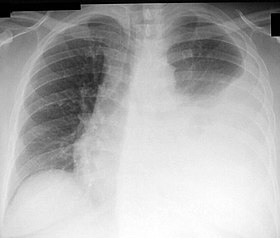| Mr. Ibrahem/Thoracentesis | |
|---|---|
 Chest X-ray showing a left-sided pleural effusion (right side of image) that was than treated with thoracentesis. | |
| Pronunciation | /ˌθɔːrəsɪnˈtiːsɪs/ |
| Other names | Pleural tap, catheter thoracostomy, thoracocentesis, paracentesis thoracis |
| Specialty | Emergency medicine |
| Complications | Pneumothorax, bleeding, low blood pressure, injury to spleen or liver[1] |
| Types | Diagnostic, treatment[1] |
Thoracentesis is a medical procedure to remove fluid from the pleural space for diagnostic or treatment purposes.[1] For diagnosis it is indicated if the cause is unclear and more than 1 centimeter of fluid is present.[1] For treatment it is done to improve shortness of breath.[1] If the fluid reoccurs despite multiple drainages a long term catheter may be placed or pleurodesis may be carried out.[1]
The procedure is typically done with the person sitting and leaning over a table.[1] The location can be verified with ultrasonography at the bedside.[1] The area is cleaned with chlorhexidine and local anesthetic is injected.[1] A hollow needle is than inserted just above a rib at the scapular line.[1] The needle is slowly advanced until fluid is aspirated, after which the catheter is slide into the chest and the needle withdrawn.[1] A collection container may than be attached.[1]
Complications may include pneumothorax, bleeding, low blood pressure, and injury to the spleen or liver.[1] Previously, only about 1.5 liters of fluid would be removed due to the concern of increased risks of reexpansion pulmonary edema with greater volumes.[2] This concern; however, appears to be unfounded and all the fluid present can likely be safely drained.[2] Coughing normally occurs as the lung reexpands.[1]
Thoracentesis was first performed in 1850 by Morrill Wyman and Henry Ingersoll Bowditch.[3] In the United States the procedure can cost about 2,000 USD.[4] The technique had been proposed earlier by Hippocrates in 400 BC.[3] The term is from Greek θώραξ thōrax meaning "chest" and κέντησις kentēsis meaning "puncture".[5]
References edit
- ^ a b c d e f g h i j k l m n o p q r s t u "How To Do Thoracentesis - Pulmonary Disorders". Merck Manuals Professional Edition. Archived from the original on 16 June 2022. Retrieved 8 August 2022.
- ^ a b Farkas, Josh (12 August 2019). "PulmCrit- Large volume thora: Can we drain 'em dry?". EMCrit Project. Archived from the original on 29 January 2022. Retrieved 8 August 2022.
- ^ a b Sebastian, Anton (6 February 2018). A Dictionary of the History of Medicine. Routledge. p. PT1366. ISBN 978-1-351-46999-9. Archived from the original on 10 August 2022. Retrieved 8 August 2022.
- ^ "Thoracentesis". www.mdsave.com. Archived from the original on 5 August 2020. Retrieved 9 August 2022.
- ^ Haubrich, William S. (November 2003). Medical Meanings: A Glossary of Word Origins. ACP Press. p. 240. ISBN 978-1-930513-49-5. Archived from the original on 2022-08-10. Retrieved 2022-08-08.